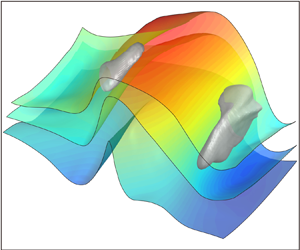Article contents
Experimental study on low-speed streaks in a turbulent boundary layer at low Reynolds number
Published online by Cambridge University Press: 18 September 2020
Abstract

A study of low-speed streaks (LSSs) embedded in the near-wall region of a turbulent boundary layer is performed using selective visualization and analysis of time-resolved tomographic particle image velocimetry (tomo-PIV). First, a three-dimensional velocity field database is acquired using time-resolved tomo-PIV for an early turbulent boundary layer. Second, detailed time-line flow patterns are obtained from the low-order reconstructed database using ‘tomographic visualizations’ by Lagrangian tracking. These time-line patterns compare remarkably well with previously observed patterns using hydrogen bubble flow visualization, and allow local identification of LSSs within the database. Third, the flow behaviour in proximity to selected LSSs is examined at varying wall distances ( $10 < y^+ < 100$) and assessed using time-line and material surface evolution, to reveal the flow structure and evolution of a streak, and the flow structure evolving from streak development. It is observed that three-dimensional wave behaviour of the detected LSSs appears to develop into associated near-wall vortex flow structures, in a process somewhat similar to transitional boundary layer behaviour. Fourth, the presence of Lagrangian coherent structures is assessed in proximity to the LSSs using a Lagrangian-averaged vorticity deviation process. It is observed that quasi-streamwise vortices, adjacent to the sides of the streak-associated three-dimensional wave, precipitate an interaction with the streak. Finally, a hypothesis based on the behaviour of soliton-like coherent structures is made which explains the process of LSS formation, bursting behaviour and the generation of hairpin vortices. Comparison with other models is also discussed.
$10 < y^+ < 100$) and assessed using time-line and material surface evolution, to reveal the flow structure and evolution of a streak, and the flow structure evolving from streak development. It is observed that three-dimensional wave behaviour of the detected LSSs appears to develop into associated near-wall vortex flow structures, in a process somewhat similar to transitional boundary layer behaviour. Fourth, the presence of Lagrangian coherent structures is assessed in proximity to the LSSs using a Lagrangian-averaged vorticity deviation process. It is observed that quasi-streamwise vortices, adjacent to the sides of the streak-associated three-dimensional wave, precipitate an interaction with the streak. Finally, a hypothesis based on the behaviour of soliton-like coherent structures is made which explains the process of LSS formation, bursting behaviour and the generation of hairpin vortices. Comparison with other models is also discussed.
Information
- Type
- JFM Papers
- Information
- Copyright
- © The Author(s), 2020. Published by Cambridge University Press
References
REFERENCES
- 27
- Cited by


